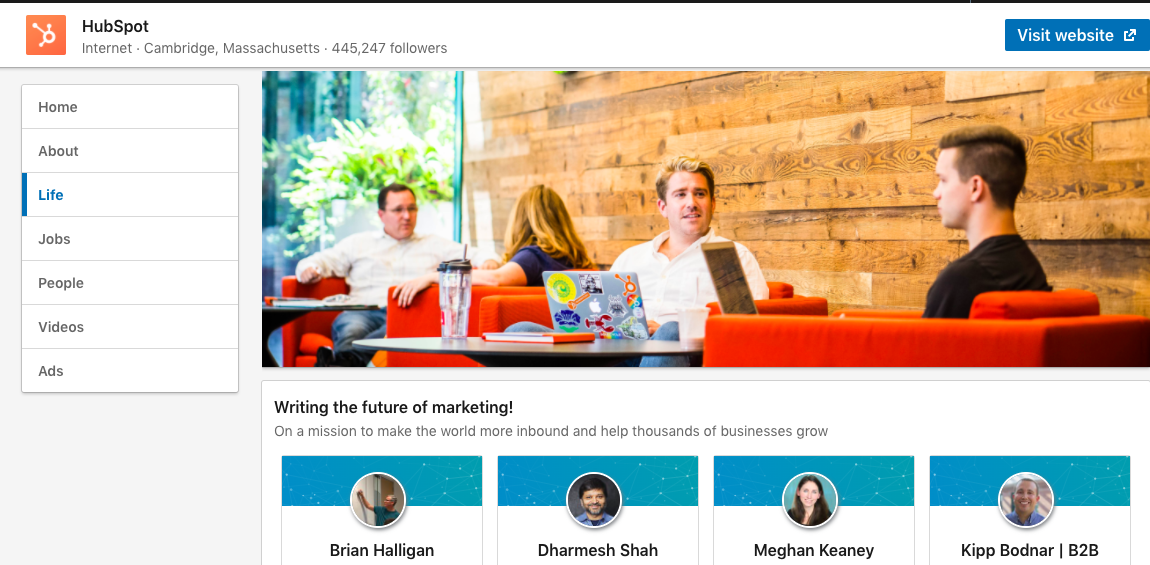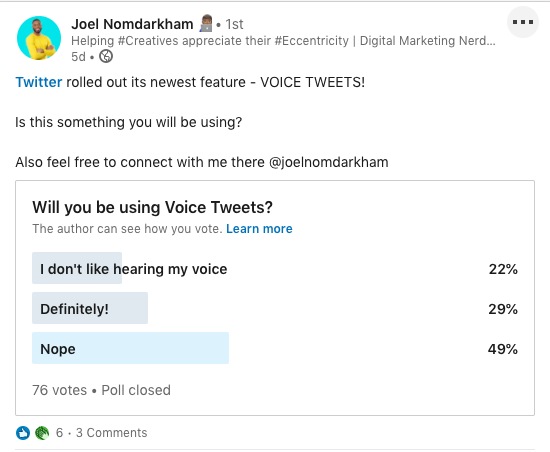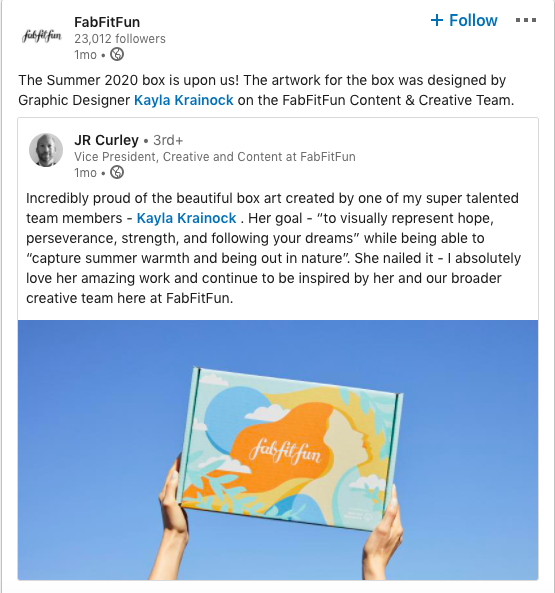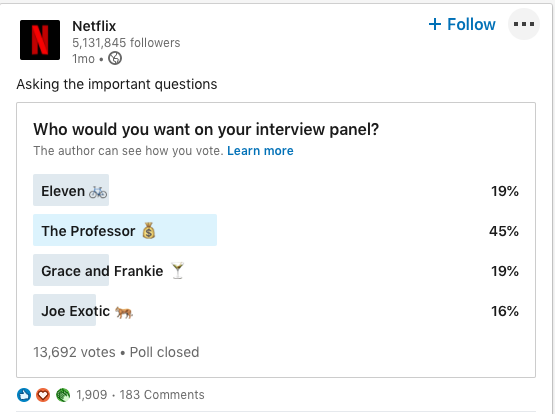Almost every morning, I log onto LinkedIn. I like to stay updated about the changes in the marketing industry and congratulate my peers on their recent accomplishments. And, of course, I love looking at the new and exciting marketing campaigns brands roll out.
Traditionally, LinkedIn is a place for B2B marketing. The unique user base of professionals and students makes the social networking service a hub for business and networking. Plus, four out of five LinkedIn users hold decision-making positions within their company.
Naturally, a professional audience is going to be a great fit for B2B marketing.
Recently, however, LinkedIn has become the home of B2C marketing as well.
So now, every morning I log into LinkedIn, I’m greeted with a mix of company types advertising their brands and offers. Let’s talk about how — and why — B2C marketing can fit into LinkedIn, and other reasons why the channel is usually known as a place for B2B marketing.
For instance, I spend a lot of time in marketing groups on LinkedIn and tend to engage with content that relates to marketing topics. Earlier, I came across an ad for a video marketing business:
LinkedIn’s native and video ads, like the one above, allow advertisers to reach a large target audience by putting it on the news feed of their preferred target segment.
An ad like this is something I’d expect to see based on my LinkedIn behavior. Because I actively engage with content and video marketing posts in my feed, I was shown an ad that targeted those interests and my behavior on the platform. Using LinkedIn for B2B marketing is a popular choice because of the platform’s unique reach.
“LinkedIn’s Sponsored Content helps surface relevant content for quality prospects in our B2B market, effectively merging our inbound strategy with cost-effective lead generation,” says Kipp Bodnar, HubSpot’s Chief Marketing Officer.
Marketers for B2Bs can reach their goals with a tailored content strategy using LinkedIn’s offerings — like a sponsored main feed post. At every stage of the sales lifecycle, LinkedIn offers a way to nurture professional leads.
Can B2C Marketers Engage LinkedIn Audiences?
LinkedIn is a great platform for B2B marketing, but it’s increasingly popular for B2C marketers as well. For instance, the unique audience can be leveraged for stylized campaigns that work for the professional when they’re not working.
To illustrate, it’s likely that professionals have purchasing power within their homes. If your primary audience is children, a secondary audience, like their parents, can be reached on LinkedIn.
Additionally, promoted and sponsored content on LinkedIn is less easy to identify on main feeds. The posts are notated, but blend into news feeds so they’re not distracting. Plus, an imbalance of B2C material on the website suggests the opportunity for it to make an impact on users.
Generally, there is an audience for nearly every industry on LinkedIn. Not only are customers just customers — they’re also professionals. There’s a good chance a segment of that audience can be found and brought to the next stage of their journey.
1. Relate to the interests of your audience outside of work.
The content on LinkedIn is commonly centered around a professional environment. B2Cs can either highlight that atmosphere or use the lack of non-professional content to their advantage when thinking of a marketing strategy.
If you frame marketing messages outside of the traditional “work” landscape of LinkedIn, your content will stick out because it’s different. Your content could be that brain break your audience needs when they need a break from the day and browse social media.
Let’s look at entertainment company HBO. The corresponding LinkedIn account has posts that have little to do with going to work, but instead, supports their brand. For instance, for Mental Health Awareness month, the company posted a supercut of shows and movies that have characters living with mental illness:
HBO repurposes content they already have to create marketing messages that relate to the interests of their professional audiences. But they do this by catering to other interests, such as causes that are important to the brand and its users. They post trailers and release schedules, so segmented customers can keep up to date.
You don’t have to strictly adhere to the business atmosphere on LinkedIn — play around with different sources for content. You can make a huge impression on the channel, just by using what makes your brand special.
2. Drive engagement with content that fosters brand awareness.
What makes your brand stick out from competitors? Whatever it is, use that to your advantage on LinkedIn.
Many B2C company profiles on LinkedIn use the page to highlight business wins and people news. This lets customers see who is behind the companies they are thinking about supporting and clues them in to what’s important to that business.
Lululemon is an athleisure company with a LinkedIn page dedicated to championing team members. The content is work-related but gives a branded touch. Take this video, which illustrates life at the company from employees around the world:
This is a route to take, if you don’t want to stray too far away from the professional emphasis on LinkedIn, but want to etch out a company culture-based approach. Congratulating employees on a webinar they were featured on or announcing a business standpoint on topical issues sheds light on what’s important to your brand.
These types of posts can live anywhere on your LinkedIn profile , and let customers know more about your business beyond just the product. It’s a great mid-cycle tactic to retarget leads.
3. Use LinkedIn Audience Network to identify potential reach.
LinkedIn’s Audience Network is part of the Marketing Solutions tool set. Here, you can identify potential reach and who from your ideal audience is using LinkedIn. To use Audience Network, all you need is a sponsored campaign.
When you open Audience Network, you’re able to choose different categories of potential audiences, like “Arts and Entertainment” and “Education” to include or exclude from your campaign. You might notice that some categories, like “Family and Parenting,” are great for B2C markets.
Audience Network also gives you campaign performance details. There, you’ll find how well your campaign is performing among audiences. You’ll see metrics such as impressions, clicks, and views, in addition to conversion rates.
If you’re not ready to start a LinkedIn campaign, or want more data about who in your industry is using LinkedIn, check out these resources:
- The Ultimate List of Marketing Statistics for 2020
- Share of U.S. adults using social media, including Facebook, is mostly unchanged since 2018
- LinkedIn Industries List, Rankings and Statistics
4. Budget yourself for success.
If you’re using LinkedIn’s ads, have your budget identified. Ultimately, the amount you spend is up to you, but keep in mind that you’ll be participating in a cost-per-click, auctioning system.
You and advertisers with similar audiences will bid on an advertising slot to be shown. Choose between the bid types that will bring you the results you need. For example, if you want to increase brand awareness, the maximum pay-per-1,000-impressions (CPM) type is most likely going to be your winner.
In addition to bids, advertisers can set a daily and total budget. Total budgets are the absolute maximum you’re willing to spend, while daily budgets have a little more flexibility. They allow for the campaign to be running until you stop them.
LinkedIn ads can range from $2-$15, depending on your ad, bid, and campaign settings. Some ad and bid types are more cost-effective than others, so explore all of your options.
Set aside enough to run a full campaign. For instance, how much are you going to spend in a day as opposed to a month? Let’s say you’re using CPM ads and paying $5 for every 1,000 impressions a post gets for 30 days. Would you have the estimated $6,000 in ad spend for 30,000 impressions?
If you don’t necessarily have the budget to advertise using LinkedIn, don’t get discouraged. There are still plenty of other ways to get your messages seen by the right people, like making main post feeds really pop — we’ll cover that next.
5. Use main feed posts to market on a budget.
Use main feed posts to your advantage. This is an especially great move if your company has a Page and growing network on the channel.
If your company is followed by several thought leaders, what you post on your page shows up on their main feeds. If they interact with the post, like sharing or leaving a comment, that interaction will be shown to their network. If that thought leader is in your industry, your post will be exposed to a large ideal audience.
Video, photos showing company culture, and offers are great for LinkedIn marketing. An ebook offer, for example, provides something valuable and interesting for target customers.
This digital marketing thought leader used a main feed poll to grow his network and engage followers:
A poll like this is just one way you can use feeds to grow an audience that will engage with your content. If you post about their interests, like social media for marketers, you’re likely to boost engagement.
Main feed posts can be treated as a basic social media post — part of a larger goal. Perhaps that goal is to expand your company’s reach or convert more leads. Build your content strategy around that goal and you’ll be off to a great start.
6. Save money by having a company page.
If you have a business profile for any social media channel, like Facebook for Business or Twitter Business, Company Pages on LinkedIn are similar. They’re a space for businesses to have their own profile with personalization offerings for branding and networking.
For instance, if you’re in the healthcare industry, you can use your Company Page to grow a community of patients and other professionals. You can interact with the members you follow, post to engage your network, and use the CTA link for your website.
You’ll have customizable options for growing a network and audience. Additionally, you’ll be able to engage with employees and share posts that are directly related to your company.
Some unique features of having a Company Page include the option to update the community with news, an improvement in search engine discovery, and, if you choose, a Career Page to post new jobs and opportunities.
Career Pages are a separate entity just for recruiting and company branding, but they can be linked to your Company Page. Additionally, you can add a tab that showcases company culture and configure it to introduce what it’s like to work at your company:

LinkedIn users looking at Company Pages can get a feel for what a company is about, offerings, and available opportunities. Check out this ultimate guide to get started making your own.
In the meantime, let’s look at how some B2C brands are using their LinkedIn accounts for marketing.
1. Madewell
New York-based retailer Madewell’s LinkedIn is all about branding and culture. The account focuses on what makes up the Madewell brand and the culture of their community.
For instance, in support of Mental Health Awareness month, Madwell’s account has a post about how employees at the company take charge of their mental health, and it encourages followers to invest in what makes them happy:
When I came across this post, I saw that Madewell supports mental health as a company. Other causes I saw from photos and captions told me how Madewell takes steps to reduce their ecological footprint.
By looking at content that championed working moms and women-led local businesses, I got an idea of the company’s ideal audience. Women who see themselves in the culture Madewell has fostered with their LinkedIn account will be interested in what the brand has to offer.
Looking at the overview of Madewell’s LinkedIn presence, I was able to get a full view of how the channel is a perfect fit for brand awareness. As a professional, I felt connected interacting with content that was created to introduce me to the company’s atmosphere, like the “zen playlist.”
2. Spotify
Spotify has two Company Pages: One specifically for business, called Spotify Brands, and one for customers, which is the main Page. If you’re part of a larger B2C that also has a large business clientele, think of having a page just for B2B efforts.
Spotify does a great job of updating customers and introducing leads from an employee perspective. For instance, up until recently, the streaming service had a limit of 10,000 songs an account holder can “like”. When the limit was lifted, the company posted a blog written by a Spotify engineer that explained how it wasn’t an easy job:
This post informs their network about one of Spotify’s own explaining a company-wide decision. LinkedIn is where members learn about industry news, so picking it to promote the blog was a great choice. It connected professionalism and brand awareness with content.
For their B2C market, it’s important for Spotify to connect their network with company culture. They also host a series called “Quickfire Questions” where employees are followed around their respective offices answering questions about themselves.They also host “How It’s Made,” a series where engineers explain the inception of a product or feature, such as Spotify’s Mobile Web Player.
As a consumer, if I feel like I know how the products and services of a company are developed, and the people behind the business are relatable, I’ll feel a sense of community. I’ll regularly visit the website and page for updates.
3. Microsoft
Microsoft’s LinkedIn presence is built around how their products foster a community of collaboration and education. These themes tie together the bulk of Microsoft’s content on LinkedIn.
Let’s look at the above-the-fold video on their Company Page, as an example. The video highlights Microsoft employees based in France for Mother’s Day. It highlights and celebrates women working from home with their children, and sends a message that they’re a business that cares about their teams.
In a repost from Microsoft Education, the content introduced a Teams update centered around student and teacher success. An education and collaboration focus informs the community while tying it back into a scenario many are experiencing: The challenge of making a school atmosphere at home.
Microsoft’s ads share actionable offers, such as a series of free online classes, AI summits, webinars, and certifications. They inspire action in prospects as well as existing customers. Audiences who want to know how Microsoft’s products are valuable to them or explore extra educational opportunities are exposed to what the company can do to help.
4. FabFitFun
FabFitFun is a seasonal subscription box service that strives to empower customers to live happier and healthier lives through brand discovery. However, the corresponding LinkedIn page isn’t focused on the product as much as employee success and culture.
This company shows how leaning into the professional side of LinkedIn as a B2C is a possibility. FabFitFun’s posts consist largely of reposts of employees and organic content about staff accomplishments.
For example, one of their posts congratulates an employee on the design of the Summer 2020 box. The post talks about inspiration of the design and includes a photo.
The post gives a visual of the FabFitFun product and tells the story behind how designs are conceptualized. Another post shares an article where the company’s Head of Influencer Marketing was interviewed about reality television influencers. Another post promotes a piece written by the VP of Marketing about how Los Angeles Tech Companies support their local communities.
FabFitFun’s approach to using LinkedIn involves building a network and sharing company stories. Network building comes from reposting outside sources when employees are mentioned, and company stories are shown to characterize the brand.
If someone came across a post from FabFitFun, like one that shared an award for “Best Subscription Box of 2019 for Women,” they would know right off the bat that the company is regarded as one of the best by their audience. Though the company hasn’t recently posted any ads, they still use their main feed posts to introduce leads to the business.
5. YETI
Consumer goods brand, YETI, takes a completely engaging approach to their posts. From scrolling through their LinkedIn content, the theme of exploration comes to life with visually compelling multimedia.
Their current above-the-fold video announces a collection inspired and forged by minerals from the Earth and shows how YETI creates products and how their products work. Someone who wasn’t familiar with the brand could look at the 15-second clip and learn that they sell a line of outdoor lifestyle products, like tumblers.
Posts like these quickly catch the eye of consumers and inform them about the brand. The language implies that the product is inspired by how “Mother Nature works best,” and leans into the professional culture on LinkedIn.
YETI also posts offers, like a limited-time, free streaming service where you can watch 10-minute videos of scenic places, like Colorado, Big Island, and Oregon. It’s the perfect piece of content for someone scrolling through LinkedIn looking for a distraction during their workday. For YETI, it’s a smart way to drive traffic.
6. Warby Parker
The eyewear company Warby Parker posts LinkedIn content that mostly centers around brand discovery. For instance, the headline informs customers how much their products cost, and some page posts are dedicated to product announcement videos.
Aside from those features, the brand also has a 15-slide presentation about optometry. It includes information about the company, its values and products, and some information about how to work for Warby Parker as an optometrist.
A recruiting document like this also gives prospects a compact document they can look through to get a feel for Warby Parker. In three slides, someone can learn about the business’s history, values, and products.
The company also has its own hashtag, #teamwarby, used by employees and fans. Hashtags are a way to build community among social media pages and their followers and help pages get noticed by an audience.
For instance, if I were an optometrist following the #optometrist hashtag on LinkedIn, it’s likely I would come across a couple of posts from Warby Parker and learn what it means to be a part of #teamwarby. As a consumer, the photos and videos posted by Warby Parker highlight a company that prioritizes employees and customers.
7. Away
Away is a retailer selling luggage, backpacks, and other travel accessories. Their LinkedIn Company Page is a fabulous example of how to turn a stranger into a lead.
Having known nothing about the company, one click on the “About” section told me a lot: the business’s history, why it was founded, and their values. After reading that Away has been recognized by Forbes, Fast Company, TIME, and even LinkedIn, I noticed a cool shiny badge that reads, “Recognized On LinkedIn’s Top Startups,” which is hyperlinked to the official article.
Away doesn’t have any ads or videos on their Page, but they do have engaging content, from announcing collections and partnerships, (like one with tennis champion Serena Williams). As I continued to scroll, I saw beautiful, modern collections that follow unique themes.
For example, this small line of luggage was inspired by Pantone’s Color of the Year:
I don’t know much about choosing the right luggage, but I know quite a bit about color theory, so this post pulled me in almost instantly. Away’s content does a great job of connecting household names to their product so audiences can follow suit.
Take the partnership with Serena Williams, for example. Some might not know about Away, but their cover story features one of the highest scorers in women’s tennis, someone more people know.
Before my visit to Away’s page, I was a stranger to their brand, but after interacting with just a few elements of their Company Page, I was more comfortable with the idea of purchasing from the company. I learned how their company can fit into my lifestyle from their content.
8. Fenty
Fenty is a global fashion brand that leverages captivating multimedia to tell their story and depict the brand. For instance, the current above-the-fold video is an overview of The 6-20 Collection styles, with the caption sharing the inspiration behind the collection.
What is interesting about nearly every Fenty post is that they each include a hashtag or link. These elements inspire action. For instance, in the product rollout video, the caption ended with a link to the website. Another post had an exclusive offer for half-off and a link to the landing page.
I love the idea of adding a linkable word or phrase in every post, like the sale offer. Buyers ready to make a purchase don’t have to search to find the website, which means there’s less of a possibility they’ll lose interest during that journey.
I also get an immediate idea of who their target customer is. The content reflects young adults in the high-fashion space who enjoy clothing based on neutral colors. Multimedia depicts the talent of young creatives, whether it be in models, photographers, or videographers, and shows how their creations speak to customers.
Fenty uses unique branding techniques to style their content. Almost every image is watermarked across the center with the brand’s logo, and every video has an endless scroll of the logo running along the bottom of the screen. If you want inspiration on how to market your brand in innovative ways, Fenty’s LinkedIn goes against the norm and tries new strategies.
9. Netflix
Streaming service Netflix also has an interesting approach to LinkedIn marketing. Their company image on LinkedIn is “doing the best work of your life,” with content built around community engagement.
For example, one of their posts is a poll:
Followers of the Netflix Company Page recently voted on who they’d want on their interview panel and included characters from Netflix Originals. The company also asks their followers questions like “What corporate buzzword needs to be retired for-ev-er?” (That question has garnered over 2,000 responses).
Netflix’s LinkedIn presence has fun energy and encourages vibrant discussions. Hosting Q&A formats like polls and open-ended questions is a tactic that fosters a sense of belonging when visiting the page.
Additionally, Netflix keeps the LinkedIn community clued in about upcoming Netflix releases and partnerships (like their multi-year deal announcement with Nickelodeon). That way, current customers checking their feeds will be clued in about what’s going on and leads can find something related to their interests.
On LinkedIn, Netflix creates content that adheres to work-life balance. It sparks conversations about the workplace that might be brought up at a watercooler or virtual happy hour but also includes fun entertainment news about upcoming projects and events happening on the service.
At first glance, I was confused as to why B2C brands are popping up on LinkedIn. But when you think about it, professionals aren’t just professionals — they’re also parents, siblings, people with lives outside of work. Because of this, it’s totally possible to tap into those outside-of-work interests on a platform meant for sharing and connecting — focus on how and who when building those connections.
![]()
Original Entry: Can B2C Marketing Succeed on LinkedIn? is shared from https://blog.hubspot.com/marketing/linkedin-b2c-marketing via https://blog.hubspot.com/marketing
Check out the original post, Can B2C Marketing Succeed on LinkedIn? that is shared from https://putyourfamilyfirst.wordpress.com/2020/06/23/can-b2c-marketing-succeed-on-linkedin/ via https://putyourfamilyfirst.wordpress.com



No comments:
Post a Comment